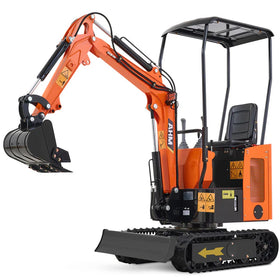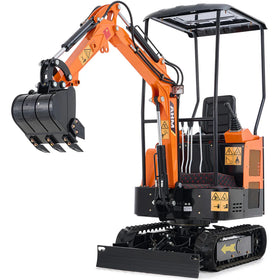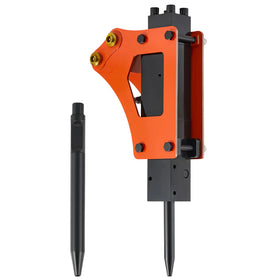One of the most expensive mistakes you can make is choosing the wrong excavator bucket teeth, especially for a mini excavator. Depending on the soil conditions you are working in, there is already a good chance that your bucket teeth may be wearing out every 1-3 months. The wrong bucket teeth can add hundreds to your budget in unnecessary replacement costs in a year.
The right mini excavator bucket teeth, on the other hand, reduce strain on your machine, improve digging capacity, and last twice as long in appropriate conditions - that's the kind of math that actually makes sense for your bottom line.
That’s why understanding mini excavator bucket teeth types comes down to matching the tooth design to what you’re actually planning to work on.
Excavator Bucket Teeth Types Explained
Different types of excavator bucket teeth are designed to handle specific soil conditions and applications. So, matching tooth design to your work will determine efficiency and how frequently you’ll have to replace them.
1. Chisel Teeth
Chisel teeth feature a broad design that narrows into a flat chisel shape at the working edge. This wide profile creates a large surface area that resists abrasive terrain and wears down more slowly than pointed designs.
Common applications:
- General hauling and material loading
- Leveling and trenching in loose soil
- Sand, gravel, and topsoil excavation
- Projects requiring flat-bottom trenches
2. Rock Chisel Teeth
Rock chisel teeth add extra material thickness for heavy-duty applications while keeping the flat edge profile. Common applications for rock chisel teeth are:
- Rock excavations and quarrying
- Breaking through hard, rocky soil
- Abrasive conditions requiring durability
- Working on mixed rock and soil
3. Single Tiger Teeth
Sharp, pointed design of Single Tiger Teeth concentrates the excavator’s power into a small penetration point for breaking through compact materials. Common applications for single tiger teeth are:
- Penetrating compact soil and clay
- Breaking through frozen ground
- Digging in hard, compacted materials
- Trenching in tough conditions
4. Twin Tiger Teeth
A two-pronged profile provides dual penetration points while maintaining the concentrated force. Common applications for twin tiger teeth include:
- Digging ditches and narrow trenches
- Breaking through extremely hard surfaces
- Precision trenching around utilities
5. Heavy-Duty Teeth
Heavy-duty teeth contain extra wear material in critical areas, which extends their service life in tough conditions. Here are some common applications for heavy-duty bucket teeth:
- Rock excavation and breaking
- Mining and quarrying operations
- Working on extremely abrasive soil conditions
6. Flare Teeth
This wider, flared design increases surface area for digging and scooping operations. Here are common applications for flare teeth:
- Working on softer soils
- Handling and loading loose material
- Applications where bucket fill matters most

What Are the Most Popular Excavator Bucket Types for Mini Excavators?
Mini excavators work with specialized bucket configurations that match their compact size. Mini excavator bucket sizes range from specialty 6-inch buckets to 36-inch buckets, depending on machine weight.
1. Narrow Trenching Buckets
Narrow trenching buckets are designed with straight cutting edges for deep trenches in confined spaces. They are mostly used for utility line installation and repair, pipeline excavations, and cable laying operations.
Narrow Trenching Bucket Sizes:
- 8-inch (200mm): Ultra-narrow utility work
- 12-inch (300mm): Standard utility trenching
- 18-24 inch: Medium trenching applications
2. Skeleton Buckets
Skeleton buckets are designed to separate larger materials from finer aggregates while excavating. They are used for material screening and separation, recovering rocks from sediment, construction site cleanup, and agricultural field preparation.
3. Plain Grading Buckets
Plain grading buckets feature wide, flat profiles with smooth cutting edges and no teeth for clean surfaces. They are mainly used for final grading and surface leveling, ditch cleaning and maintenance, loading soft materials (like sand), and finishing work before paving.

How to Choose the Right Bucket Type For a Mini Excavator
Consider these factors when selecting the appropriate mini excavator bucket teeth type.
Match Teeth to Soil Conditions
- Soft soil: Standard chisel teeth
- Rocky material: Heavy-duty or rock chisel teeth
- Compacted soil: Tiger teeth for penetration
- Frozen ground: Sharp tiger teeth
- Mixed conditions: General-purpose teeth
Consider Replacement Costs
- Teeth wear out after 6 weeks of regular use
- Replacement is needed every 1-3 months
- Forged teeth last twice as long as cast ones
- Abrasive soils require more frequent replacements
Material Quality
- Cast teeth: Budget-friendly and lighter weight
- Forged teeth: Stronger and longer-lasting
- Manganese steel: Superior hardness
- Tungsten carbide tips: Maximum wear resistance

Best Excavator Buckets From AHM Corps
1. AHM 8-Inch Narrow Trenching Bucket - $159.99
The AHM 200mm narrow bucket excels at digging precise trenches where standard buckets might create excessive width. Built from manganese steel with a 7.9-inch width profile, this 37.3-pound bucket handles work like pipeline excavations and utility work efficiently on 1-2 ton mini excavators.
Key specs:
- 7.9-inch (200mm) width for narrow trenches
- Two-tooth design penetrating soil
- 0.98-inch pin diameter fits standard configurations
- Perfect for 12-inch sonotube holes without backfill
2. AHM 12-Inch Narrow Trenching Bucket - $169.99
The AHM 300mm narrow bucket provides 50% more width while maintaining the precision trenching capability. This 44.3-pound bucket handles medium-width trenching where 8-inch buckets come across too narrow.
Key specs:
- 11.8-inch (300mm) width
- Manganese steel construction
- Two-tooth configuration
- Same mounting as the 8-inch model
3. AHM 20-Inch Plain Grading Bucket - $359.99
The AHM 500mm plain bucket features a toothless flat cutting edge for smooth, level surfaces. With 1.06 cubic feet of capacity and 19.7-inch width, this 42.7-pound bucket handles finish grading, loading soft materials, and ditch cleaning better than the competition.
Key specs:
- Flat cutting edge creates clean surfaces
- No teeth reduces the risk of striking utility lines
- Perfect for sand and fine soil loading
- Ideal for slope leveling work

The Bottom Line
Choosing appropriate excavator bucket teeth types depends mainly on the soil conditions. Most operators working in mixed conditions get the best results from general-purpose chisel teeth, while tiger teeth work best for frozen ground and heavy-duty teeth for rock.
The AHM bucket lineup covers all the essential applications - narrow trenching buckets for precision utility work, plain grading buckets for smooth finishes, and skeleton buckets for separating materials. Remember to match your bucket and teeth to work conditions, replace teeth every 1-3 months, and you'll maintain productivity in your mini excavator operation.







